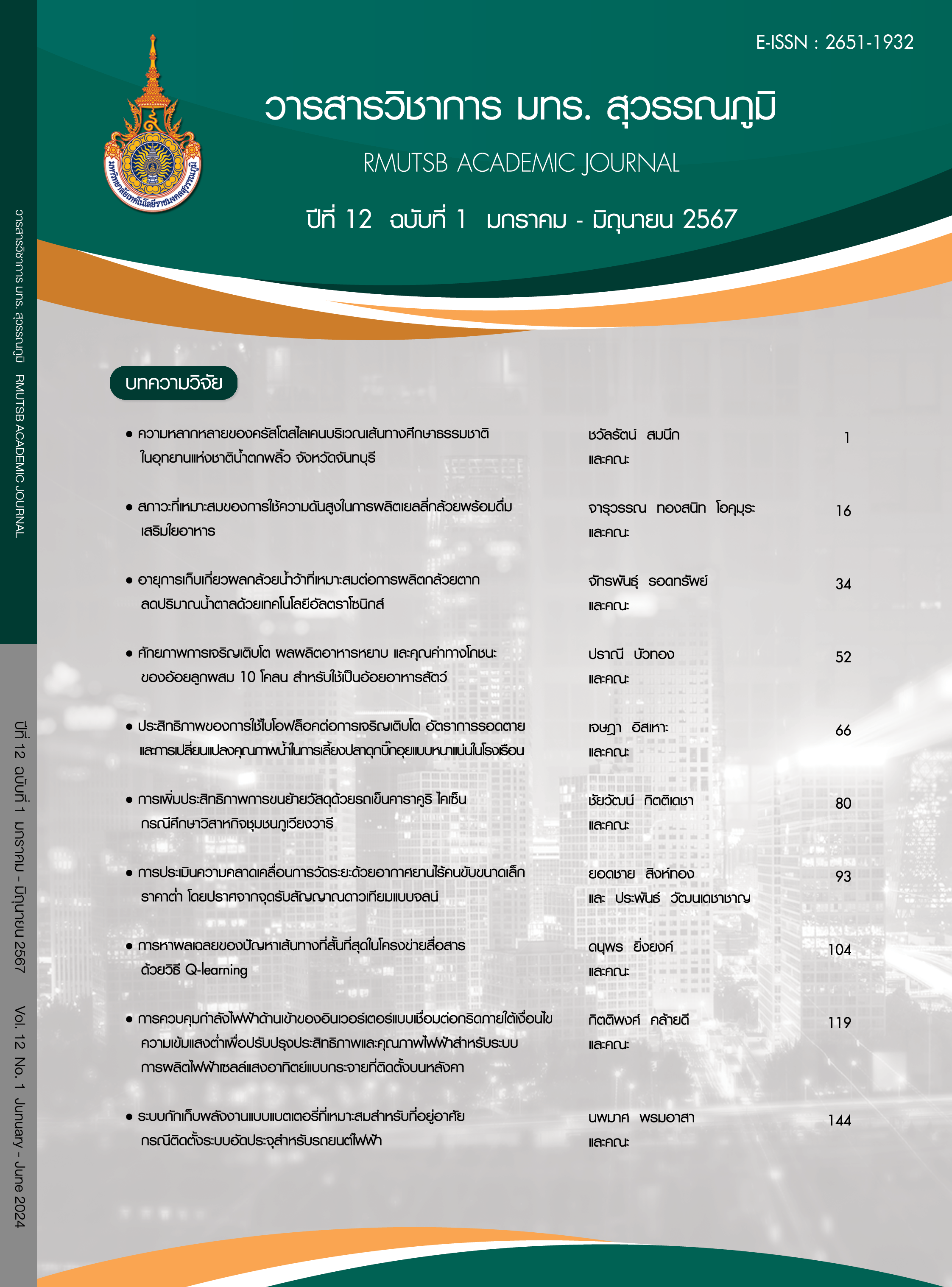Error assessment of distance measurement by small, low-cost unmanned aerial vehicles without real time kinematic point
Main Article Content
Abstract
The application of unmanned aerial vehicles (UAVs) in various fields has gained global recognition, particularly in civil engineering projects where they play a significant role. In tasks such as rapid surveying and resource-efficient operations, small-sized, cost-effective UAVs have become instrumental. This research aims to propose a methodology for assessing distance measurement accuracy using small-sized, low-cost UAVs, eliminating the need for costly Real Time Kinematic (RTK) satellite signal receivers, diverging from previous studies that often-required extensive resources and complex procedures. The research methodology involved three key steps: 1) Building a geometric shape distance measurement model consisting of three shapes: triangle, square, and pentagon 2) Defining the lengths of each side randomly, ranging from 34-38 meters and 3) Measuring the lengths using a tape measure and comparing the results with measurements obtained through image processing from aerial photographs at an altitude of 90 meters. The testing was conducted in an obstacle-free, flat terrain. The comparative analysis revealed that the average measurement errors for triangle, square, and pentagon shapes were 0.12, 0.15, and 0.14 meters, respectively, or 0.98%, 0.43%, and 0.37% in percentage terms. These discrepancies may be attributed to unclear reference points in certain positions within the images. However, when compared to human-based measurements, the UAV measurements demonstrated minimal motion, making them suitable for preliminary surveying work.
Article Details

This work is licensed under a Creative Commons Attribution-NonCommercial-NoDerivatives 4.0 International License.
Published manuscript are the rights of their original owners and RMUTSB Academic Journal. The manuscript content belongs to the authors' idea, it is not the opinion of the journal's committee and not the responsibility of Rajamangala University of Technology Suvarnabhumi
References
Aobpaet, A. (2020). Surveying efficiency on slope areas with GNSS technology: A case study of Laem Chabang Hospital, Chonburi Province. Kasetsart Engineering Journal, 33(110), 009-020.
Bhatsada, A., Towprayoon, S., Garivait, S., Wangyao, K., Laphitchayangkul, T., Ishigaki, T., & Chiemchaisri, C. (2020). Evaluation of UAV photogrammetric accuracy for mapping of open dump based on variation of image overlaps. KMUTT Research & Development Journal, 2, 133-142.
Boonlua, T. (2014). The adaptive use of unmanned aerial vehicle in aerial photography for urban design: A Case study of Mahasarakham University, Khamreing Campus. Academic Journal of Architecture, 63, 55-68.
Boonlue, T. (2018). Applying drone for generated building information modeling (BIM) for urban architecture, the case study of That Phanom District, Nakhon Phanom Province. Journal of the Faculty of Architecture King Mongkut's Institute of Technology Ladkrabang, 26(1), 137-148.
Cho, J. M., & Lee, B. K. (2023). GCP and PPK utilization plan to deal with RTK signal interruption in RTK-UAV photogrammetry. Drones, 7(4), 265.
Du, M., Li, H., & Roshanianfard, A. (2022). Design and experimental study on an innovative UAV-LiDAR topographic mapping system for precision land levelling. Drones, 6(12), 403.
Inthachot, I., & Buachart, C. (2021). Application of unmanned aerial vehicle for building construction inspection. The 26th National Convention on Civil Engineering (CEM-36-1-CEM-36-6). Online: Engineering Institute of Thailand.
Jitt-Aer, K., Buaphiban, T., & Sriprasert, A. (2020). Applying aerial imagery from unmanned aerial vehicle for digital maps. Sripatum Review of Science and Technology, 12(1), 93-105.
Jitphairot, K., & Kruawit, P. (2022). A Stud of image processing technique by using an unmanned aerial vehicle for wearing surface assessment. The 27th National Convention on Civil Engineering (STR53 1-STR53 8). Chiang Rai: Engineering Institute of Thailand.
Laphitchayangkul, T., Phasada, A., & Wangyao, K. (2022). Application of low-cost unmanned aerial vehicle for accurate mapping: Case study at King Mongkut's University of Technology Thonburi, Ratchaburi Residential College. KMUTT Research and Development Journal, 43(3), 311-323.
Mapping Technology Division. (2015). Operation manual for kinetic satellite surveying network system (RTK Network) in individual survey work. Retrieved 8 April 2023, from https://www.dol.go.th/km2/Documents/book%20km%202558/rtk.pdf
Moore, A., Gutierrez, J., Dill, E., Logan, M., Glover, J. S., Young, S., & Hoege, N. (2023). Accuracy assessment of two GPS fidelity prediction services in urban terrain. 2023 IEEE/ION Position, Location and Navigation Symposium (PLANS) (pp. 25-33). Monterey: IEEE.
Moore, A., Rymer, N., Glover, J. S., & Ozturk, D. (2023). Predicting GPS fidelity in heavily forested areas. 2023 IEEE/ION Position, Location and Navigation Symposium (PLANS) (pp. 772-780). Monterey: IEEE.
Nakata, Y., Iwasaki, K., Shimoda, S., & Torita, H. (2023). Understanding microtopography changes in agricultural landscapes through precision assessments of digital surface models by the UAV-RTK-PPK method without ground control points. Smart Agricultural Technology, 5, 100269.
Poommirat, P., Sengtan, A., Maparasop, P., Limpanasittichai, N., & Pranchai, A. (2021). Health assessment of Avicennia spp. forest through an unmanned aerial vehicle located at the Upper Gulf of Thailand. Thai Journal of Forestry, 40(2), 17-28.
Punzet, S., & Eibert, T. F. (2023). Impact of additional antenna ground planes on RTK-GNSS positioning accuracy of UAVs. Advances in Radio Science, 20, 23-28.
Sanhueza, D., Picco, L., Paredes, A., & Iroumé, A. (2022). A faster approach to quantify large wood using UAVs. Drones, 6(8), 218.
Zhang, Y., & Kamargianni, M. (2023). A review on the factors influencing the adoption of new mobility technologies and services: autonomous vehicle, drone, micromobility and mobility as a service. Transport reviews, 43(3), 407-429.
Zhao, X., Meng, Y., Qi, F., Wang, L., & Zhu, X. (2023). A vertical channel-enhanced fusion method based on RINS and barometric altimeter for UAVs in GNSS denial environments. IEEE Transactions on Instrumentation and Measurement, 72, 8504212.


